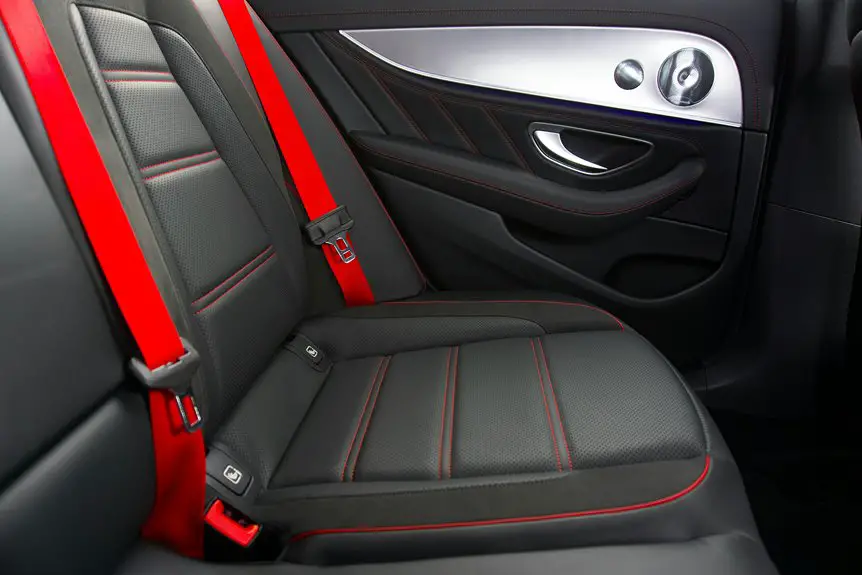To get a tight, professional upholstery finish, start by choosing a tightly woven fabric with natural stretch like cotton blends. Clear and prep a stable workspace, and gather tools such as a staple gun and pliers. Stretch your fabric evenly by securing one side, then pulling taut before stapling from the center outward, keeping staples spaced 1-2 inches apart. Avoid overstretching and maintain consistent tension. Mastering these basics guarantees a smooth result and sets you up to explore advanced techniques.
Table of Contents
Key Takeaways
- Choose tightly woven, naturally elastic fabrics like cotton blends or microfiber for easier stretching and a durable finish.
- Secure one side of the fabric, then alternate pulling opposite sides evenly to maintain consistent tension without puckering.
- Use a quality staple gun to attach fabric, placing staples 1-2 inches apart and starting from the center of each side.
- Smooth fabric continuously with your hands while stretching, checking alignment and grain direction for a professional appearance.
- Avoid overstretching and place staples at least half an inch from edges to prevent fabric damage and ensure a tight hold.
Choosing the Right Upholstery Fabric for Stretching
Before you begin stretching upholstery fabric, you need to choose a material that can handle tension without tearing or losing shape.
Look for fabrics with a tight weave and some natural elasticity, like cotton blends or microfiber. These materials give you enough stretch to pull tight while maintaining durability.
Choose tightly woven fabrics with natural stretch, such as cotton blends or microfiber, for durable upholstery.
Avoid delicate fabrics like silk or loosely woven linens—they’re prone to damage when stretched.
Also, consider the fabric’s thickness; too thin and it might rip, too thick and it won’t stretch well. You’ll want something that balances flexibility with strength.
Finally, keep the fabric’s pattern in mind; smaller, repetitive designs are easier to align when stretched, ensuring a professional-looking finish.
Picking the right fabric upfront saves you frustration later.
Preparing Your Workspace and Materials
Before you start stretching your upholstery fabric, make sure your workspace is clear and clean to avoid any damage or dirt.
Gather all essential tools like a staple gun, scissors, and fabric adhesive so you have everything within reach.
Being organized will help you work efficiently and achieve the best results.
Clear and Clean Area
To start, clear at least three feet of workspace around your upholstery project to give yourself enough room to stretch the fabric without restrictions.
Remove any clutter, tools, or furniture that might get in your way. Sweep or vacuum the area to eliminate dust and debris that could stick to your fabric or damage it during the stretching process.
A clean, open space helps you move freely and guarantees your fabric stays pristine. Make sure your surface is flat and stable to support your piece securely.
This preparation prevents unnecessary wrinkles or snags while you work. Taking these simple steps before you begin sets the stage for a smooth, professional upholstery finish that looks polished and lasts longer.
Gather Essential Tools
Once your workspace is clear and clean, gather the tools you’ll need to stretch your upholstery fabric effectively.
Start with a staple gun and plenty of quality staples to secure the fabric tightly. You’ll also want a pair of sharp scissors for trimming excess material and a flathead screwdriver or pliers to remove old staples if you’re reupholstering.
A measuring tape helps guarantee precise fabric placement, while a spray bottle filled with water can make stretching easier by slightly dampening the fabric.
Consider using a rubber mallet to gently tap fabric into place without causing damage.
Finally, keep a clean cloth handy to smooth out wrinkles as you work.
Having these tools ready will make the stretching process smoother and help you achieve a professional finish.
Techniques for Stretching Fabric Evenly
Achieving an even stretch in upholstery fabric requires a mix of patience and technique. Start by securing one side of the fabric to your frame, then gently pull the fabric taut across to the opposite side.
Avoid pulling too hard in one spot; instead, apply steady, consistent tension. Work your way around, alternating sides to maintain even tension, which prevents wrinkles and puckering.
Smooth the fabric with your hands as you go, keeping an eye on alignment and grain direction. If you notice unevenness, release a little tension and adjust before re-stretching.
Taking your time guarantees the fabric lays flat and looks professional. Remember, even stretching is about balance—stretching just enough without distorting the fabric’s pattern or weave.
Tools That Make Upholstery Fabric Stretching Easier
Using the right tools can make stretching upholstery fabric much easier and more precise. Start with a good-quality staple remover to carefully take out old fabric without damaging the frame.
A pair of pliers or locking pliers helps grip and pull the fabric taut, giving you better control. Upholstery tacks or a staple gun are essential for temporarily holding the fabric as you stretch it evenly.
Consider using a fabric stretcher tool, which clamps the material and applies consistent tension across the surface, reducing wrinkles. A rubber mallet can gently tap tacks into place without tearing the fabric.
Finally, having a measuring tape guarantees you maintain evenness and alignment. These tools together streamline your work, helping you achieve a smooth, professional finish with less effort.
Securing the Fabric for a Smooth Finish
To get a smooth finish, you’ll need to place your staples carefully, ensuring they hold the fabric firmly without causing puckers.
Keep the tension consistent as you work around the piece to avoid wrinkles and sagging.
Mastering these techniques will give your upholstery a clean, professional look.
Proper Staple Placement
Three key points will help you secure upholstery fabric with staples for a smooth, professional finish.
First, place staples about 1 to 2 inches apart along the edges to guarantee even hold without puckering.
Second, start stapling from the center of each side and work outward toward the corners; this prevents fabric bunching and maintains tension.
Third, avoid staples too close to the fabric’s edge—aim for at least half an inch in to prevent tearing.
Use a heavy-duty stapler and press firmly to embed staples securely into the frame.
As you staple, keep the fabric taut but don’t overstretch it. Proper staple placement is essential to keep your fabric tight and smooth before moving on to tension adjustments.
Tension Maintenance Techniques
Although proper staple placement sets a strong foundation, maintaining consistent tension is crucial to achieving a smooth, wrinkle-free upholstery finish.
To keep your fabric taut and secure, follow these tension maintenance techniques:
- Work from the center outwards: Pull the fabric tight from the middle and staple toward the edges to evenly distribute tension and avoid puckering.
- Use a stretching tool: Employ a fabric stretcher or pliers designed for upholstery to grip and pull fabric firmly without damaging it.
- Check and adjust frequently: Continuously assess the fabric’s tautness as you staple, releasing and re-stretching any areas that show slack or wrinkles.
Tips for Maintaining Fabric Tension Over Time
Since fabric tension can loosen over time, you’ll want to take proactive steps to keep your upholstery looking tight and smooth.
Regularly check your furniture for any sagging or wrinkles and address them promptly. Avoid placing your upholstered pieces in direct sunlight or near heat sources, as this can weaken fibers and cause stretching.
Keep an eye out for sagging or wrinkles and protect fabric from sunlight and heat to prevent stretching.
Clean your fabric gently with recommended products to prevent damage that might loosen tension. When you notice slight slack, use a staple remover to carefully lift and re-stretch the fabric, then re-secure it firmly.
Consider using fabric protectors or tensioning sprays designed for upholstery to maintain elasticity. By staying attentive and performing small adjustments, you’ll preserve the professional finish you worked hard to achieve.
Frequently Asked Questions
Can I Stretch Upholstery Fabric on Curved Furniture Edges?
You can stretch upholstery fabric on curved edges, but it takes patience and careful work. Use gradual tension and secure the fabric with staples or tacks, smoothing wrinkles as you go to achieve a tight, professional look.
How Do Different Fabric Types React to Stretching?
Different fabrics dance differently when stretched: cotton grips firmly, leather stretches like a slow river, and velvet resists like a stubborn mule. You’ll need to adjust your technique based on each fabric’s unique stretch behavior.
What Is the Best Way to Remove Wrinkles After Stretching?
You’ll want to use a handheld steamer or a warm iron with a pressing cloth to gently remove wrinkles. Always test a small area first and avoid direct heat to prevent fabric damage or shrinking.
Can Upholstery Fabric Be Steamed During Stretching?
Yes, you can steam upholstery fabric while stretching it. Steaming relaxes fibers, making stretching easier and reducing wrinkles. Just be careful with delicate fabrics and avoid over-wetting to prevent damage or distortion during the process.
How Do I Fix Fabric That Has Stretched Too Tight?
If your fabric’s too tight, you’ll want to carefully release some tension by loosening staples or tacks slightly. Then, gently pull and reposition the fabric to ease it, preventing wrinkles or damage before restapling securely.
- Does Chiffon Fabric Stink - July 15, 2025
- Does Chiffon Fabric Affect the Economy - July 15, 2025
- Does Cotton Fabric Have a Nap - July 15, 2025







